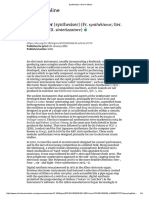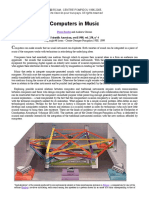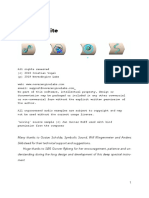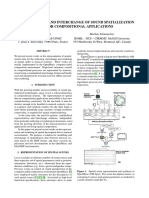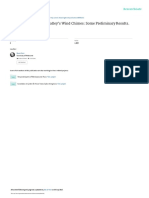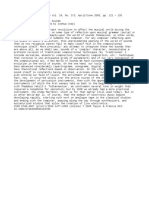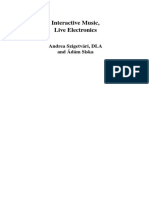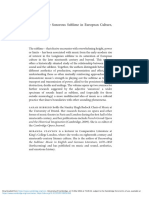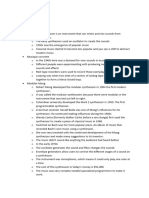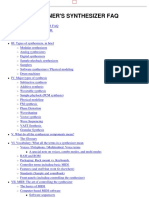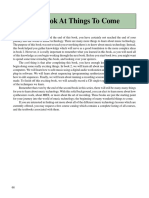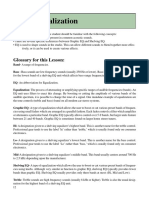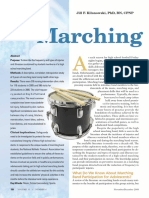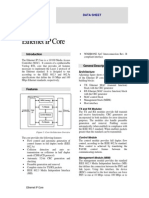Unit Three:
Synthesizer
Basics
In this unit, you will be introduced to a wonderful musi-
cal instrument called a synthesizer. Lesson Nine provides
a short history of synthesizers while Lesson Ten will teach
you some of the most important things about operating a
synthesizer such as selecting different sounds. In Lessons
Eleven and Twelve, you will be introduced to some basic
performance controls and you will get a brief taste of even
creating your own sounds from scratch.
46
� LESSON
9 Synthesizer History
After completing this lesson, the student should be familiar with the following concepts:
• The first synthesizer design was patented in 1897 by Thaddeus Cahill.
• In the 1960’s, Bob Moog designed the first modern synthesizer.
• In the mid 60’s and early 70’s, you had to connect the parts (modules) of a synthesizer with patch cords to
make a sound. Synthesizers were expensive at this time and were monophonic.
• In the mid 70’s and early 80’s, synthesizers became polyphonic, and could remember sounds. Patch cords
were no longer used to create sounds, but sounds were still called patches. Synthesizers also be-
came more reasonably priced.
• In the mid to late 1980’s, synthesizers dropped to modern prices (typically $1000-2000) and many synths
were multitimbral. 8-16 notes of polyphony were common and synthesizers could remember more
sounds than ever. Synths got better at imitating acoustic instruments.
• Today, synthesizers can typically play 64-128 notes at once, and 8-32 different sounds at once. Synthesiz-
ers usually take the shape of a keyboard, tone module or a software program.
• Almost all synthesizers have power, audio (to get sounds to mixers), and MIDI jacks.
• Home keyboards do not count as synthesizers because they don’t usually let you make your own sounds.
• Mother keyboards are keyboards which can’t make any sound, but are used to control other synthesizers
and tone modules.
• Two advantages of tone modules are that they take up less space than keyboards, and cost less.
Glossary for this Lesson:
Bob (Robert) Moog- Developed voltage-controlled synthesizer modules in the mid 1960’s and is thus
considered the father of modern synthesis. Founded the Moog Music synthesizer company and is currently
president of Big Briar.
Keyboard- A term used for synthesizers which have keyboards as well as home keyboards. Keyboard also
refers to the keys on a synthesizer.
MIDI- Musical Instrument Digital Interface. The jacks on the back of synthesizers that allow keyboards
and computers to play synthesizers.
Module- A discreet part of an early synthesizer. One had to connect the modules using patch cords to
create a sound.
Monophonic- A synthesizer is monophonic if it can play only one note at a time. Most early synthesizers
were monophonic.
Multitimbral- A synthesizer that can create more than one sound at a time.
47
�Lesson Nine: Synthesizer History Basic Music Technology
Patch- A name for a sound on a synthesizer. Sounds were called patches because of the patch cords used to
create the sounds. Synthesizers today don’t have patch cords anymore, but sounds are still referred to as
patches.
Patch Cords- Short instrument cables used on early synthesizers to connect the different modules of the
synthesizer together to create a sound.
Polyphonic- A synthesizer that can play more than one note at a time.
Polyphony- A measurement of how many notes a synthesizer can play at once.
Thaddeus Cahill- Inventor of the first synthesizer in 1897.
Tone Module- A synthesizer which does not have a keyboard. Tone Modules are played from keyboards or
other devices which have MIDI.
Vladimir Usachevsky- Professor of composition at Columbia Princeton University who was highly influ-
ential in the design of the first modern synthesizer. He designed several of the modules which are used in
synthesizers today.
Wendy Carlos- A student of Vladimir Usachevsky and friend of Bob Moog. She was highly influential in
the design of the first Moog synthesizers, providing Dr. Moog with suggestions and feedback about his
creations. Her album “Switched-On Bach” was the best selling classical album from the time it was re-
leased in 1968 until 1997. She is also well-known for her score to the film A Clockwork Orange and the
development of several new methods of tuning instruments.
48
� LESSON
9 Synthesizer History
For some people, the word “synthesizer” has a synthesizers were. Most synthesizers being made
magical sort of ring to it. You might picture a rock were monophonic, which means that they could only
star on stage with fireworks, smoke, and lights, or play one note at a time. Synthesizers were also very
maybe the mad scientist type, working in a sound very expensive at this time. Most synthesizers cost
laboratory, turning knobs with impossible looking between $5,000 and $10,000 with some costing even
names like “frequency modulation” or “wavetable more. Synthesizers were still pretty hard to use. You
start index” and making strange sounds late into the may recall that synthesizers started out as a bunch of
night. Before we begin to learn about the different devices. Synthesizers made at this time were
synthesizer’s place in modern music, it is important still made up of lots of individual devices called
to understand a little bit about the history of modules, but they were all in one case. To make a
synthesizers. The synthesizer’s past is important to sound, you had to connect the different devices
us because its past is partially what has shaped the together with cables called patch cords. You also had
synthesizer’s unique place in today’s music. to set many knobs and sliders to just the right spot to
make the sound you wanted. The synthesizer couldn’t
SYNTH HISTORY remember the sounds you made, so you would have
Believe it or not, synthesizers have actually been to remember where each cord was connected and
around since 1897 when Thaddeus Cahill took out where each knob or fader was set.
patents on an instrument he called the Telharmonium.
However, the beginnings of modern synthesizers took MODERN TIMES
place in the 1950’s. Experimenters began to develop In the mid 1970’s and early 1980’s, people had
different machines that could make sound and then seen synthesizers on TV and knew what they were.
shape it in different ways. Each of these machines Synths became easier to use, too. Many synthesizers
was a completely separate device, but when could play several notes at once (sometimes as many
connected together with instrument cables, they could as 6-8 notes), so the synthesizers were said to be
make some wonderful sounds. polyphonic. The number of notes a synthesizer can
In the mid 1960’s Robert Moog, who was a play at once is its polyphony. Many synthesizers
technical assistant at Columbia-Princeton University could remember the sounds you made. Instead of
began experimenting with a new design which would having to connect lots of patch cords and reset all of
let the different electronic music machines the knobs, you would just touch a few buttons and
communicate with each other. With the help of the synthesizer would set the knobs or faders for you.
Vladimir Usachevsky (a professor at the university) (The sounds were still called patches, however, after
and Wendy Carlos (one of Usachevsky’s students) the cords that were once used to make sounds.) Most
he built the world’s first modern synthesizer. synthesizers could remember 8-64 sounds. Prices on
Bob Moog started the famous Moog synthesizer synthesizers also began to drop. Most synths fell into
company which was the first company to make the $2000-$5000 price range.
commercially available synthesizers. Wendy Carlos The mid and late 1980’s saw some big changes
recorded an album of pieces by Johann Sebastien in the world of synthesizers. Synthesizers dropped
Bach in 1968 using one of Bob Moog’s synthesizers greatly in price. You could still find synthesizers that
which was the best selling classical album of all time cost over $10,000, but most synthesizers cost
until 1997. between $1000 and $2000. Synthesizers also got a
In the 1960’s and 70’s, people didn’t know what lot better at reproducing acoustic instrument sounds.
49
�Lesson Nine: Synthesizer History Basic Music Technology
The piano sounds began to sound like real pianos, Tone modules are often rack-mountable boxes with
and the drums like real drums. Synthesizers could controls on their front panel, and jacks on their back
remember more sounds, too. Most synthesizers could panel. You can play a tone module using another key-
remember 64-256 sounds. Synthesizers could also board, or using a computer. There are two big ad-
play more notes. 8 notes was typical, but it wasn’t vantages to tone modules. First, they take up a lot
hard to find synthesizers that could play 16-32 notes less space than a keyboard version of a synthesizer,
at once. It was also at this time that the first and second, they are almost always cheaper than a
multitimbral synths became available. A multitimbral keyboard because you don’t have to pay for a key-
synth can create more than one sound at once. Most board again. Tone modules are a really good choice
synths could play 8-16 different sounds at once. if you already have at least one keyboard. Most syn-
In the 1990’s, synthesizers continued to thesizers that are made as keyboards are also made
improve. Synthesizers could play up to 64 notes at as tone modules.
once, and some could remember thousands of sounds. Finally, synthesizers can be a piece of software.
Another important thing began to happen in the These virtual synthesizers are a computer program
1990’s: it became cool to use old synthesizers. Up that turns your computer into a synthesizer. Software
until this time, the older a synthesizer was, the less synthesizers are fairly new and are still changing and
cool it was. Because these synths weren’t seen as developing rapidly.
cool, they were worth almost nothing. Young people
with very little money bought these old synths and MAKING THE CONNECTION
created a new style of music called techno. All hardware synthesizers offer a few basic
Today, most synthesizers can play 64-128 notes jacks. The exact number might vary from unit to unit,
at once, and are 8-32 part multitimbral. They can but they are generally pretty similar. First, all syn-
store thousands upon thousands of patches, and there thesizers need power. Most synths have a power con-
are more different kinds of synthesizers than ever. nector on the back. The power switch is usually lo-
cated pretty close to the power jack.
MODERN SYNTHS All synthesizers have at least one audio output
Synthesizers come in all shapes and sizes. The jack which allows you to get the synth’s sounds to a
easiest to recognize are those which have a mixer or PA system. Some synths have multiple out-
keyboard. Keyboards usually come puts. This allows you to route different sounds to
in four sizes: 49, 61, 76, or different mixer channels so that you can EQ them
88 keys. Not all differently, or add effects to just a few of the sounds.
keyboards are The 5-pin jacks found on the back of most mod-
synthesizers. ern synths are called MIDI jacks. We won’t
Mother keyboards spend much time on MIDI in this book,
can’t synthesize any as it will be the subject of an entire book
sounds, but can be used to later on. Right now, all you need to know
control other synthesizers. is that MIDI allows us to play one synthe-
Home keyboards usually have sizer from another. MIDI is what allows us
built-in speakers (synthesizers don’t) to use a mother key-
and auto accompaniments. You can’t usu- board to play a tone
ally make any new sounds on these key- module, and allows
boards, so they aren’t synthesizers either. computers to play
Synthesizers are also sometimes tone modules. synthesizers.
Tone modules are synthesizers without a keyboard.
50
�Basic Music Technology Lesson Nine: Synthesizer History
Let’s Review
1. Who created the first synthesizer? When?
2. What three people were very important to the creation of the first modern synthesizer? When?
3. What were early synthesizers like?
4. When did synthesizers become polyphonic? When could they remember your sounds?
5. When did synthesizers become multitimbral?
6. What are the three forms of modern synthesizers? What connections do they usually have?
What are the differences between home keyboards and synthesizers?
Words and Names On the Web:
To know: If you would like to see pictures of some real
synthesizers or read more about them, check
Patch
Bob Moog out the following sites :
Patch Cords
Keyboard
Polyphonic
MIDI http://www.vintagesynth.org/
Polyphony
Module http://www.novationmusic.com/
Thaddeus Cahill
Monophonic http://www.rolandus.com/
Tone Module
Mother Keyboard http://www.waldorf-gmbh.de/
Vladimir Usachevsky
Multitimbral http://www.korg.com/
Wendy Carlos
http://www.clavia.se/
Experiments:
1. Look at several different synthesizers and decide if each one is a keyboard, tone module, or piece
of software.
2. Look at the back of the synthesizers and see if you can find the audio, MIDI, and power jacks.
3. Connect each of the synthesizers in #1 to a mixer and see if you can make each one make some
sound. You teacher will help you with the tone module.
51
